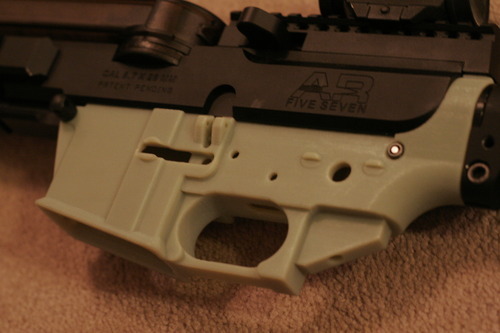Chambered in 5.7x28FN which has a lower pressure than .223
The idea of using a 3-D printer to create a gun is controversial and interesting, but it seems to still be a ways off from equaling the quality of machined parts. A gun with a major part printed that way failed after just six shots when some enthusiasts decided to give the tech a try.
Creating a printable gun is the project of Defense Distributed, which is working on what it calls the WikiWeapon. But the effort isn't far enough along to create a working firearm, so Defense Distributed used a design created by another printed-gun creator who goes by the name HaveBlue.
HaveBlue claimed in July to have fired his printed gun hundreds of times, which doesn't seem impossible given the quality of the printing. The part printed by the group is called the lower receiver, which is where a round is received from the magazine. Pictures show it to be very well made, and it appears to fit exactly to the other parts in the gun kit they used.
But the pressure of the recoil appears to have been too much for the "buffer ring," which separates the stock from the upper receiver. After firing just six shots, the gun split in two. It's a serious setback, especially considering they were firing a lower-caliber cartridge than the gun would normally shoot.
The legality of all this is unknown, not to say in dispute. It is legal to create your own firearms, but not to distribute them — and in the case of printed guns there's a bit of both going on. The ATF is looking at the subject, but for now it's all something of a grey area.
The technical aspects of the part, the failure, and the team's plans to improve it can be found at Defense Distributed's blog. You can watch the video of the test below.
Creating a printable gun is the project of Defense Distributed, which is working on what it calls the WikiWeapon. But the effort isn't far enough along to create a working firearm, so Defense Distributed used a design created by another printed-gun creator who goes by the name HaveBlue.
HaveBlue claimed in July to have fired his printed gun hundreds of times, which doesn't seem impossible given the quality of the printing. The part printed by the group is called the lower receiver, which is where a round is received from the magazine. Pictures show it to be very well made, and it appears to fit exactly to the other parts in the gun kit they used.
But the pressure of the recoil appears to have been too much for the "buffer ring," which separates the stock from the upper receiver. After firing just six shots, the gun split in two. It's a serious setback, especially considering they were firing a lower-caliber cartridge than the gun would normally shoot.
The legality of all this is unknown, not to say in dispute. It is legal to create your own firearms, but not to distribute them — and in the case of printed guns there's a bit of both going on. The ATF is looking at the subject, but for now it's all something of a grey area.
The technical aspects of the part, the failure, and the team's plans to improve it can be found at Defense Distributed's blog. You can watch the video of the test below.










Comment